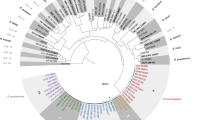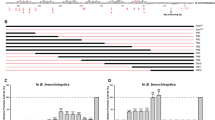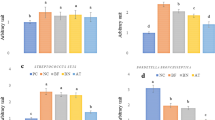Abstract
Bordetella pertussis, Bordetella parapertussis and Bordetella bronchiseptica are closely related Gram-negative β-proteobacteria that colonize the respiratory tracts of mammals. B. pertussis is a strict human pathogen of recent evolutionary origin and is the primary etiologic agent of whooping cough. B. parapertussis can also cause whooping cough, and B. bronchiseptica causes chronic respiratory infections in a wide range of animals. We sequenced the genomes of B. bronchiseptica RB50 (5,338,400 bp; 5,007 predicted genes), B. parapertussis 12822 (4,773,551 bp; 4,404 genes) and B. pertussis Tohama I (4,086,186 bp; 3,816 genes). Our analysis indicates that B. parapertussis and B. pertussis are independent derivatives of B. bronchiseptica-like ancestors. During the evolution of these two host-restricted species there was large-scale gene loss and inactivation; host adaptation seems to be a consequence of loss, not gain, of function, and differences in virulence may be related to loss of regulatory or control functions.
This is a preview of subscription content, access via your institution
Access options
Subscribe to this journal
Receive 12 print issues and online access
$259.00 per year
only $21.58 per issue
Buy this article
- Purchase on SpringerLink
- Instant access to full article PDF
Prices may be subject to local taxes which are calculated during checkout





Similar content being viewed by others
References
Cherry, J.D. Historical review of pertussis and the classical vaccine. J. Infect. Dis. 174, S259–S263 (1996).
World Health Organization. The World Health Report 2002: Reducing risks, promoting healthy life. (World Health Organization, Geneva, 2002).
van Loo, I.H., Heuvelman, K.J., King, A.J. & Mooi, F.R. Multilocus sequence typing of Bordetella pertussis based on surface protein genes. J. Clin. Microbiol. 40, 1994–2001 (2002).
Porter, J.F., Connor, K. & Donachie, W. Isolation and characterization of Bordetella parapertussis-like bacteria from ovine lungs. Microbiology 140, 255–261 (1994).
Heininger, U. et al. Clinical characteristics of illness caused by Bordetella parapertussis compared with illness caused by Bordetella pertussis. Pediatr. Infect. Dis. J. 13, 306–309 (1994).
van der Zee, A., Mooi, F., Van Embden, J. & Musser, J. Molecular evolution and host adaptation of Bordetella spp.: phylogenetic analysis using multilocus enzyme electrophoresis and typing with three insertion sequences. J. Bacteriol. 179, 6609–6617 (1997).
Goodnow, R.A. Biology of Bordetella bronchiseptica. Microbiol. Rev. 44, 722–738 (1980).
Cotter, P.A. & Miller, J.F. Bordetella. in Principles of Bacterial Pathogenesis (ed. Groisman, E.) 619–674 (Academic, San Diego, 2001).
Tillier, E.R. & Collins, R.A. Genome rearrangement by replication-directed translocation. Nat. Genet. 26, 195–197 (2000).
Mackiewicz, P., Mackiewicz, D., Kowalczuk, M. & Cebrat, S. Flip-flop around the origin and terminus of replication in prokaryotic genomes. Genome Biol. 2, INTERACTIONS1004 (2001).
Karlin, S. Detecting anomalous gene clusters and pathogenicity islands in diverse bacterial genomes. Trends Microbiol. 9, 335–343 (2001).
Stibitz, S. & Yang, M.S. Genomic plasticity in natural populations of Bordetella pertussis. J. Bacteriol. 181, 5512–5515 (1999).
Parkhill, J. et al. Genome sequence of Yersinia pestis, the causative agent of plague. Nature 413, 523–527 (2001).
Thalen, M. et al. Rational medium design for Bordetella pertussis: basic metabolism. J. Biotechnol. 75, 147–159 (1999).
Brockmeier, S.L. et al. Role of the dermonecrotic toxin of Bordetella bronchiseptica in the pathogenesis of respiratory disease in swine. Infect. Immun. 70, 481–490 (2002).
Mattoo, S., Foreman-Wykert, A.K., Cotter, P.A. & Miller, J.F. Mechanisms of Bordetella pathogenesis. Front. Biosci. 6, E168–E186 (2001).
Coutte, L. et al. Role of adhesin release for mucosal colonization by a bacterial pathogen. J. Exp. Med. 197, 735–742 (2003).
Jacob-Dubuisson, F. et al. Molecular characterization of Bordetella bronchiseptica filamentous haemagglutinin and its secretion machinery. Microbiology 146, 1211–1221 (2000).
Tuomanen, E. et al. Receptor analogs and monoclonal antibodies that inhibit adherence of Bordetella pertussis to human ciliated respiratory epithelial cells. J. Exp. Med. 168, 267–277 (1988).
Tuomanen, E.I., Nedelman, J., Hendley, J.O. & Hewlett, E.L. Species specificity of Bordetella adherence to human and animal ciliated respiratory epithelial cells. Infect. Immun. 42, 692–695 (1983).
Willems, R.J. van der Heide, H.G. & Mooi, F.R. Characterization of a Bordetella pertussis fimbrial gene cluster which is located directly downstream of the filamentous haemagglutinin gene. Mol. Microbiol. 6, 2661–2671 (1992).
Mooi, F.R., ter Avest, A. & van der Heide, H.G. Structure of the Bordetella pertussis gene coding for the serotype 3 fimbrial subunit. FEMS Microbiol. Lett. 54, 327–331 (1990).
Kania, S.A. et al. Characterization of fimN, a new Bordetella bronchiseptica major fimbrial subunit gene. Gene 256, 149–155 (2000).
Pedroni, P. et al. Cloning of a novel pilin-like gene from Bordetella pertussis: homology to the fim2 gene. Mol. Microbiol. 2, 539–543 (1988).
Livey, I., Duggleby, C.J. & Robinson, A. Cloning and nucleotide sequence analysis of the serotype 2 fimbrial subunit gene of Bordetella pertussis. Mol. Microbiol. 1, 203–209 (1987).
Henderson, I.R. & Nataro, J.P. Virulence functions of autotransporter proteins. Infect. Immun. 69, 1231–1243 (2001).
Coutte, L., Antoine, R., Drobecq, H., Locht, C. & Jacob-Dubuisson, F. Subtilisin-like autotransporter serves as maturation protease in a bacterial secretion pathway. EMBO J. 20, 5040–5048 (2001).
Moore, C.H., Foster, L.A., Gerbig, D.G. Jr., Dyer, D.W. & Gibson, B.W. Identification of alcaligin as the siderophore produced by Bordetella pertussis and B. bronchiseptica. J. Bacteriol. 177, 1116–1118 (1995).
Galan, J.E. & Collmer, A. Type III secretion machines: bacterial devices for protein delivery into host cells. Science 284, 1322–1328 (1999).
Yuk, M.H., Harvill, E.T. & Miller, J.F. The BvgAS virulence control system regulates type III secretion in Bordetella bronchiseptica. Mol. Microbiol. 28, 945–959 (1998).
Stockbauer, K.E., Foreman-Wykert, A.K. & Miller, J.F. Bordetella type III secretion induces caspase 1-independent necrosis. Cell. Microbiol. 5, 123–132 (2003).
Di Fabio, J.L., Caroff, M., Karibian, D., Richards, J.C. & Perry, M.B. Characterization of the common antigenic lipopolysaccharide O-chains produced by Bordetella bronchiseptica and Bordetella parapertussis. FEMS Microbiol. Lett. 76, 275–281 (1992).
Vinogradov, E., Peppler, M.S. & Perry, M.B. The structure of the nonreducing terminal groups in the O-specific polysaccharides from two strains of Bordetella bronchiseptica. Eur. J. Biochem. 267, 7230–7237 (2000).
Preston, A. et al. Genetic basis for lipopolysaccharide O-antigen biosynthesis in bordetellae. Infect. Immun. 67, 3763–3767 (1999).
Moxon, E.R. & Kroll, J.S. The role of bacterial polysaccharide capsules as virulence factors. Curr. Top. Microbiol. Immunol. 150, 65–85 (1990).
Weiss, A.A., Melton, A.R., Walker, K.E., Andraos-Selim, C. & Meidl, J.J. Use of the promoter fusion transposon Tn5 lac to identify mutations in Bordetella pertussis vir-regulated genes. Infect. Immun. 57, 2674–2682 (1989).
Kuwano, A., Ito, T., Tachi, H. & Hiramune, T. Comparison of the inhibitory effect of sulfamonomethoxine and other sulfonamides on capsule formation of Bordetella bronchiseptica. J. Vet. Med. Sci. 54, 1057–1059 (1992).
Frosch, M., Edwards, U., Bousset, K., Krausse, B. & Weisgerber, C. Evidence for a common molecular origin of the capsule gene loci in gram-negative bacteria expressing group II capsular polysaccharides. Mol. Microbiol. 5, 1251–1263 (1991).
Arico, B. & Rappuoli, R. Bordetella parapertussis and Bordetella bronchiseptica contain transcriptionally silent pertussis toxin genes. J. Bacteriol. 169, 2847–2853 (1987).
Boucher, P.E. & Stibitz, S. Synergistic binding of RNA polymerase and BvgA phosphate to the pertussis toxin promoter of Bordetella pertussis. J. Bacteriol. 177, 6486–6491 (1995).
Maurelli, A.T., Fernandez, R.E., Bloch, C.A., Rode, C.K. & Fasano, A. “Black holes” and bacterial pathogenicity: a large genomic deletion that enhances the virulence of Shigella spp. and enteroinvasive Escherichia coli. Proc. Natl. Acad. Sci. USA 95, 3943–3948 (1998).
Foreman-Wykert, A.K. & Miller, J.F. Hypervirulence and pathogen fitness. Trends. Microbiol. 11, 105–108 (2003).
Sambrook, J. & Russell, D.W. Molecular cloning: a laboratory manual vol. 3 (Cold Spring Harbor Laboratory Press, Cold Spring Harbor, New York, 2001).
Stibitz, S. & Garletts, T.L. Derivation of a physical map of the chromosome of Bordetella pertussis Tohama I. J. Bacteriol. 174, 7770–7777 (1992).
Parkhill, J. et al. Complete DNA sequence of a serogroup A strain of Neisseria meningitidis Z2491. Nature 404, 502–506 (2000).
Rutherford, K. et al. Artemis: sequence visualization and annotation. Bioinformatics 16, 944–945 (2000).
Nei, M. & Gojobori, T. Simple methods for estimating the numbers of synonymous and nonsynonymous nucleotide substitutions. Mol. Biol. Evol. 3, 418–426 (1986).
Whittam, T.S. Genetic variation and evolutionary processes in natural populations of Escherichia coli. in Escherichia coli and Salmonella: Cellular and Molecular Biology (eds. Neidhardt, F.C. & Curtiss, R.) 2708–2720 (ASM Press, Washington, D.C., 1996).
Guttman, D.S. & Dykhuizen, D.E. Clonal divergence in Escherichia coli as a result of recombination, not mutation. Science 266, 1380–1383 (1994).
Acknowledgements
We are grateful to S. Stibitz for help with reconciling our assembly with his map and to D. Relman and C. Cummings for access to unpublished data. We acknowledge support from the Wellcome Trust Sanger Institute core sequencing and informatics groups. This work was supported by the Wellcome Trust through its Beowulf Genomics initiative.
Author information
Authors and Affiliations
Corresponding authors
Ethics declarations
Competing interests
The authors declare no competing financial interests.
Supplementary information
Rights and permissions
About this article
Cite this article
Parkhill, J., Sebaihia, M., Preston, A. et al. Comparative analysis of the genome sequences of Bordetella pertussis, Bordetella parapertussis and Bordetella bronchiseptica. Nat Genet 35, 32–40 (2003). https://doi.org/10.1038/ng1227
Received:
Accepted:
Published:
Issue date:
DOI: https://doi.org/10.1038/ng1227
This article is cited by
-
Genome annotation and comparative functional analysis of genomic islands in Bordetella pertussis Tohama I, Bordetella parapertussis 12822, and Bordetella bronchiseptica RB50 genomes
Network Modeling Analysis in Health Informatics and Bioinformatics (2023)
-
A comprehensive resource for Bordetella genomic epidemiology and biodiversity studies
Nature Communications (2022)
-
Genomic landscapes of bacterial transposons and their applications in strain improvement
Applied Microbiology and Biotechnology (2022)
-
Genome Characteristic of Bordetella parapertussis Isolated from Iran
Current Microbiology (2022)
-
Comparative insights into genome signatures of ferric iron oxide- and anode-stimulated Desulfuromonas spp. strains
BMC Genomics (2021)



